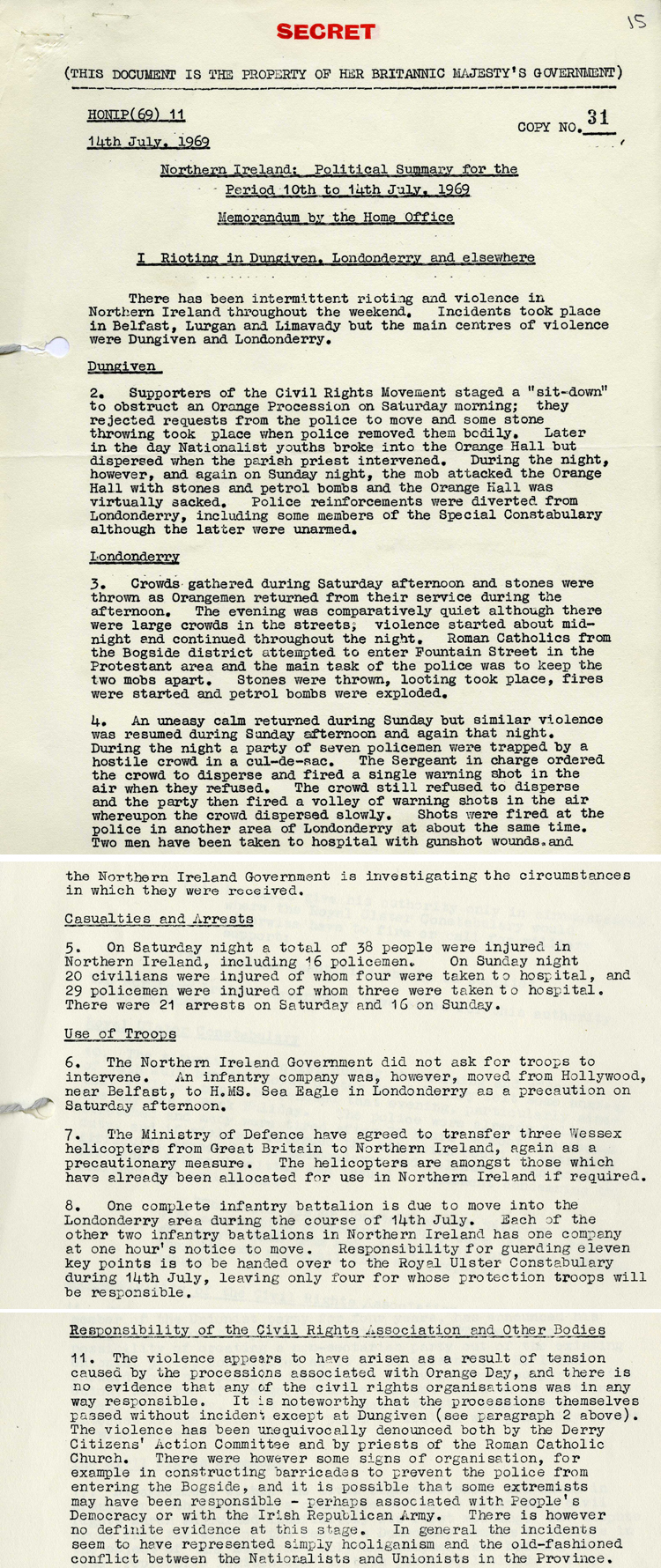
Extracts from a British government report about the political situation in Northern Ireland in July 1969 (CJ 3/52)
Transcript
Northern Ireland: Political Summary for the Period 10th to 14th July, 1969
Memorandum by the Home Office
1. Rioting in Dungiven, Londonderry and elsewhere
There has been intermittent rioting and violence in Northern Ireland throughout the weekend. Incidents took place in Belfast, Lurgan and Limavady but the main centres of violence were Dungiven and Londonderry.
Dungiven
2. Supporters of the Civil Rights Movement staged a “sit-down” to obstruct an Orange Procession on Saturday morning; they rejected requests from the police to move and some stone throwing took place when police removed them bodily. Later in the day Nationalist youths broke into the Orange Hall but dispersed when the parish priest intervened. During the night, however, and again on Sunday night, the mob attacked the Orange Hall with stones and petrol bombs and the Orange Hall was virtually sacked. Police reinforcements were diverted from Londonderry, including some members of the Special Constabulary although the latter were unarmed.
Londonderry
3. Crowds gathered during Saturday afternoon and stones were thrown as Orangemen returned from their service during the afternoon. The evening was comparatively quiet although there were large crowds in the streets; violence started about midnight and continued throughout the night. Roman Catholics from the Bogside district attempted to enter Fountain Street in the Protestant area and the main task of the police was to keep the two mobs apart. Stones were thrown, looting took place, fires were started and petrol bombs were exploded.
4. An uneasy calm returned during Sunday but similar violence was resumed during Sunday afternoon and again that night. During the night a party of seven policemen were trapped by a hostile crowd in a cul-de-sac. The Sergeant in charge ordered the crowd to disperse and fired a single warning shot in the air when they refused. The crowd still refused to disperse and the party then fired a volley of warning shots in the air whereupon the crowd dispersed slowly. Shots were fired at the police in another area of Londonderry at about the same time. Two men have been taken to hospital with gunshot wounds and the Northern Ireland Government is investigating the circumstances in which they were received.
Casualties and Arrests
5. On Saturday night a total of 38 people were injured in Northern Ireland, including 16 policemen. On Sunday night 20 civilians were injured of whom four were taken to hospital and 29 policemen were injured of whom three were taken to hospital. There were 21 arrests on Saturday and 16 on Sunday.
Use of Troops
6. The Northern Ireland Government did not ask for troops to intervene. An infantry company was, however, moved from Hollywood, near Belfast, to H.M.S. Sea Eagle in Londonderry as a precaution on Saturday afternoon.
7. The Ministry of Defence have agreed to transfer three Wessex helicopters from Great Britain to Northern Ireland, again as a precautionary measure. The helicopters are amongst those which have already been allocated for use in Northern Ireland if required.
8. One complete infantry battalion is due to move into the Londonderry area during the course of 14th July. Each of the other two infantry battalions in Northern Ireland has one company at one hour’s notice to move. Responsibility for guarding eleven key points is to be handed over to the Royal Ulster Constabulary during 14th July, leaving only four for whose protection troops will be responsible.
…
Responsibility of the Civil Rights Association and Other Bodies
11. The violence appears to have arisen as a result of tension caused by the processions associated with Orange Day, and there is no evidence that any of the civil rights organisations was in any way responsible. It is noteworthy that the processions themselves passed without incident except at Dungiven (see paragraph 2 above). The violence has been unequivocally denounced both by the Derry Citizens’ Action Committee and by priests of the Roman Catholic Church. There were however some signs of organisation, for example in constructing barricades to prevent the police from entering the Bogside, and it is possible that some extremists may have been responsible – perhaps associated with People’s Democracy or with the Irish Republican Army. There is however no definite evidence at this stage. In general the incidents seem to have represented simply hooliganism and the old-fashioned conflict between the Nationalists and Unionists in the Province.
